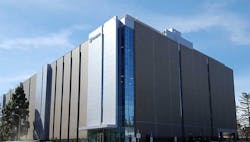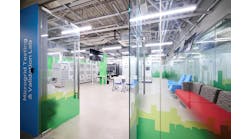After decades of building out, the data center industry is building up. Leading developers are now building multi-story data centers, boosting their capacity to house IT gear by adding vertical space. The trend is most pronounced in the two hottest data center markets, Northern Virginia and Silicon Valley, where it’s becoming more difficult to find development sites for new construction projects.
While the shift to multi-story buildings may not seem like a hot real estate trend, it’s a new direction for data center construction, which for many years focused on sturdy, single-story cement fortresses.
An example is Santa Clara, the data center capital of Silicon Valley, where CoreSite and Vantage Data Centers have shifted to four-story designs.
“Land is highly constrained here,” said Sureel Choksi, the president and CEO of Vantage Data Centers. “Because there’s not much land here, data centers are being built taller to maximize capacity. I think that we’ll continue to see that across the industry.”
The trend is coming to Ashburn, the focal point of data center development in Northern Virginia. Ashburn is home to about 5 million square feet of data center space, consisting almost entirely of one or two-story facilities.
“A lot of new buildings are coming in as two-story projects,” said Buddy Rizer, the Executive Director for Economic Development in Loudoun County. “Several users are interested in going higher than that. We want people to develop more, so we will probably allow people to build four-story data centers in Loudoun.”
Data Center Frontier Special Report: The Northern Virginia Data Center Market. Download It Now.
Digital Realty, CoreSite and RagingWire Data Centers are among those that have recently built multi-story data centers in Loudoun County. Equinix, CyrusOne and Sabey Data Centers are planning two-story facilities.
“I think people are finding two-story infrastructure more acceptable,” said Douglas Adams, the CEO of RagingWire. “I think that’s where things are going.”
From Carrier Hotel to Suburban Sprawl
From the earliest days of the Internet boom, servers and telecom equipment have been housed on the upper floors of skyscrapers in of major cities.
These carrier hotels, like 60 Hudson Street in New York, provide services to the nexus of business customers in the central business district of these cities. But both power and real estate are expensive, and in limited supply.
That’s why data center construction soon focused on the suburbs, and server farms grew horizontally, with single stories across larger footprints. It became common for single story facilities to spread out to make room for more capacity, spanning 300,000 to 500,000 square feet of space.
As Internet growth accelerated in 2015, Google shifted to a multi-story model, building four-story data centers in Iowa and Oklahoma. The taller facilities allow Google to pack more servers into the same real estate footprint, providing more bang for its buck on each of its huge cloud campuses.
Google’s four-story data center on its cloud campus in Mayes County, Oklahoma. (Photo: Google)
“It’s a natural evolution of our campus strategy,” Joe Kava, the Vice President of Data Centers at Google, told DCF in a 2016 interview. “If you’re looking to preserve the amount of expansion on a campus, you look to densify and get the most out of every square foot, and that means multi-story.”
CoreSite: Focus on Land Use
While the design shift at Google drew attention to the trend, the real pioneer in vertical data centers has been CoreSite, one of the real estate investment trusts (REITs) focused on the data center sector. The company got its start as largest colocation provider at One Wilshire, the iconic 30-story telecom hub in downtown Los Angeles. It went on to build a national footprint of 20 data centers in eight major markets.
Brian Warren, CoreSite’s Senior Vice President of Engineeering and Product, said the company has a history of optimizing the yield of data center space from available real estate.
“The industry’s getting smarter about the use of land,” said Brian Warren, CoreSite’s Senior Vice President of Engineering and Product. “You have fewer locations and you have to drive efficiency in the use of land. It’s not anything new for us.”
An example: At a time when its rivals in Ashburn were building one-story facilities, CoreSite took a different approach just down the road at its campus in Reston. After retrofitting an existing structure for its first data center, CoreSite rolled out a five-story design for VA2, a greenfield build on adjacent land. The top floor houses mechanical and electrical infrastructure, with the remaining four floors dedicated to data halls for tenants.
The VA2 data center building on the CoreSite campus in Reston, Virginia. (Photo: Rich Miller)
Last year CoreSite completed SV7, a four-story facility that is the tallest data center in Santa Clara. The company built several two- and three-story data centers before going even higher with SV7.
CoreSite’s strategy is to develop multi-tenant ecosystems in major markets, creating a campus environment with multiple facilities operating as one. Warren said that often involves making the most of “infill locations” – parcels of land in close proximity to existing sites. In major markets with limited development sites, that may mean working with smaller pieces of land and building vertically.
Data Center Frontier Special Report: The Silicon Valley Data Center Market. Download It Now.
“It’s a tradeoff,” said Warren. “You have to consider the efficiencies of land relative to the additional considerations of a multi-story data center. From a structural perspective, it’s a little simpler to do one story. With multi-story, you’re pre-planning for electrical and mechanical infrastructure across multiple floors. We obviously feel the efficiencies gained (from multi-story) outweigh the additional considerations.”
One of those efficiencies is the time saved from building several vertical buildings on a single campus, as opposed to constructing lower buildings and having to procure additional land – which also means additional permitting and approvals.
“It compresses our total timeline compared to developing multiple buildings,” said Warren.
CoreSite will further refine its multi-story strategy on its newest campus in Northern Virginia. In August 2016 it bought the Sunrise Technology Park, an office development just a quarter mile from the company’s existing campus The acquisition will provide CoreSite with space to expand its Reston data center operations.
CoreSite plans to retrofit two existing buildings on the property, and then construct two new buildings to serve as connectors so staff and customers can move between data centers through internal corridors. One of the new buildings will be a four-story “infrastructure tower” that will house mechanical and electrical equipment to serve the data halls in the other buildings.








